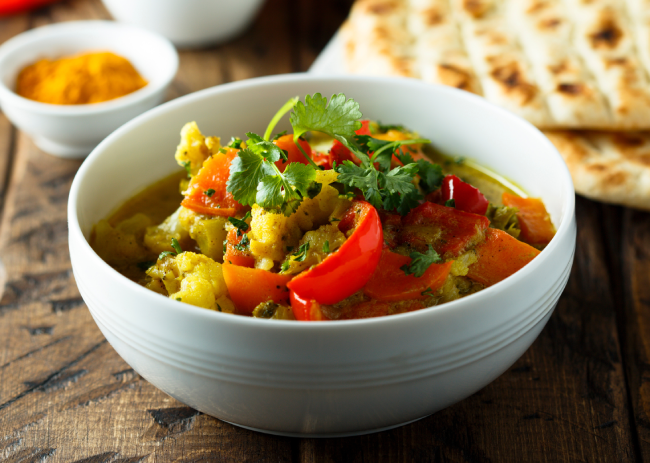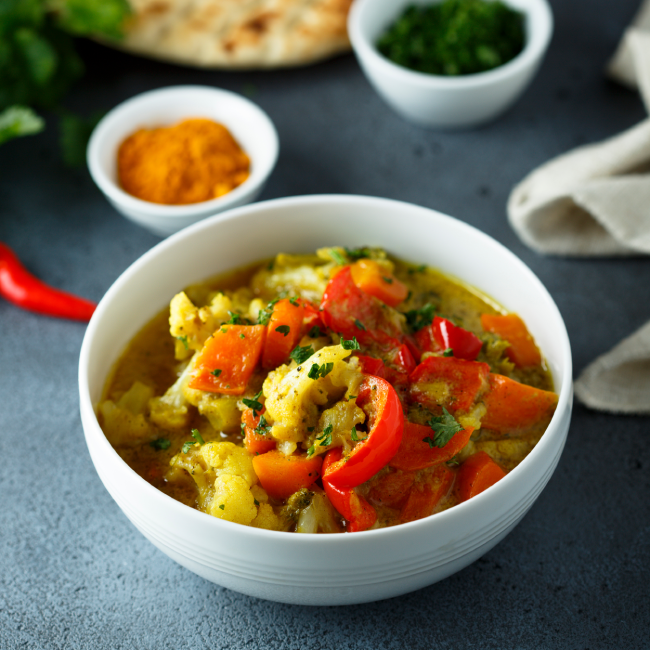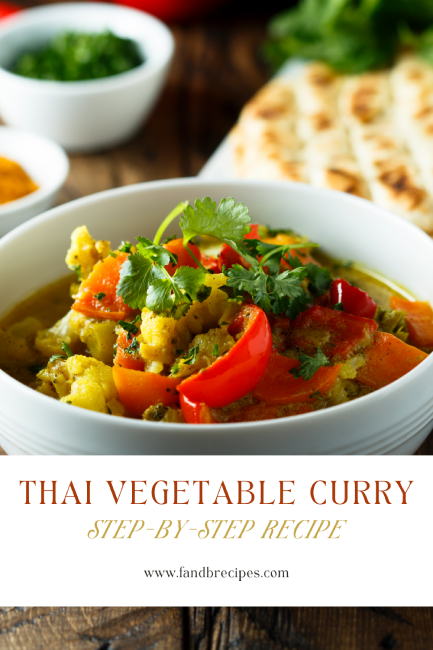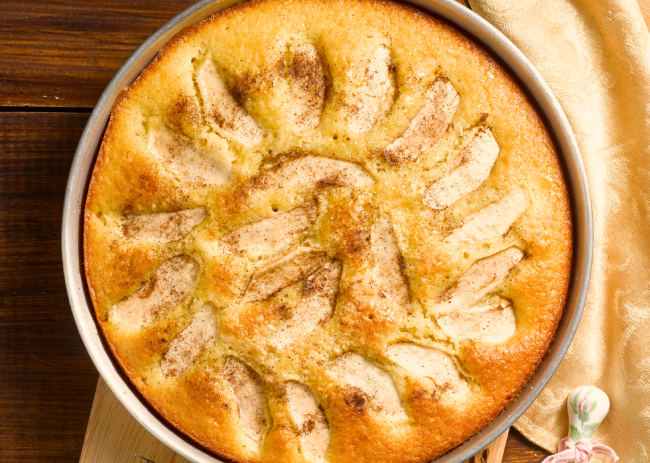Thai Vegetable Curry: Step-By-Step Recipe
Have you ever had a great curry made with vegetables? If not, then Feast your sights on this and prepare a delicious curry. The Thai Vegetable Curry is a fantastic choice for your upcoming plant-based meal. It includes mushrooms, snow peas, baby corn, bell peppers, onions, and a Thai red paste and coconut curry. A veggie lover’s paradise when served over rice!
This Thai recipe is vegetarian, vegan, gluten-free, and keto friendly. You can also prepare this in a pan using tofu as the vegetarian protein source. In addition, it is a great option for weekday meals and takes less than 30 minutes to prepare.
In addition, if you want a nutritious dinner full of flavorful, robust vegetables then this recipe is for you. Your whole family will enjoy this. This dish will come together fast and give a good amount of flavour if you have a can of coconut milk on hand.
Let’s try this wonderful Thai vegetable curry recipe and indulge our palates.
What Is Thai Vegetable Curry?
Thai curries are usually made with a variety of curry pastes. They can be either vegetarian or non-vegetarian. Coconut milk with a curry paste made of chillies, onions, garlic, and various herbs all together cooked well to make this curry. All this gives the curry a great aroma.
In addition, the red Thai curry and the green Thai curry are two of the most popular and most ordered Thai curry. Yet, many of us are unsure whether to order red or green Thai curry when dining out.
Thai red curry is very soupy because of the addition of coconut milk or water to the chilli paste. The curry varies according to region. Red chillies in Thailand can be hotter than those in other nations. Thus, the taste of curry prepared in other areas differs from that of curry prepared in Thailand. But, the ingredients remain the same.
Green Thai Curry is the same as red one in flavour but it gets a different colour from green chillies. It also includes basil and coriander to enhance the flavour and green colour.
To prepare this dish, we’ll make a curry with a colourful paste of Thai red curry.
Why This Recipe Works
If you enjoy Thai red curry and want to make it at home, try this recipe. Making your own red curry paste is simple and easy, it tastes far superior to the paste available at the market.
Above all, making your own Thai red curry paste also ensures that the dish has no preservatives. Although you can use curry paste from any store, we recommend making your own.
You can cook this Thai vegetable curry with dried red chilli and then soak it to remove the harshness and heat. Soaking the chillies adds a lot of flavour to the dish.
You can add vegetables, seafood, chicken, meat, or anything else to this Thai curry and can make it your own.
Ingredients Required to Make Thai Vegetable Curry
They are the primary components of this recipe for vegetarian Thai red curry:
- Vegetables: Use colourful carrots, bell peppers, eggplants, broccoli, mushrooms, butternut squash, and pumpkin. Before applying pressure, add veggies that need longer to cook, such as pumpkin, green beans, eggplant and carrots. Add veggies after a pressure cooking session. For instance, zucchini and bell peppers.
- Coconut milk: To give the meal structure and flavour, full-fat coconut milk is crucial. It imparts a creamy texture and nutty flavour.
- Kaffir Lime leaves: The Kaffir lime stems then add a citrusy lemon flavour. If you are unable to locate these difficult-to-find leaves, then add ½ a lemon.
- Soy Sauce: Thai cooking requires the use of soy sauce. Soy sauce adds salt, umami, and a hint of sweetness to a dish.
- Coriander Seeds: It has a light aroma and a flavour that is lemony, earthy, and a little sweet.
- Cumin Seeds: Use Cumin seeds whole or ground. It contributes to the earthy and warming flavour of food.
- Thai Basil Or Italian Basil: Basil has a very distinct flavour. Even when cooked, the sturdy leaves of Thai basil keep structure and flavour. That is, add fresh as a garnish to add a herbaceous kick or add it during the cooking process.
Tools Required to Make Thai Vegetable Curry
You can use any of these pieces of equipment to make this Thai Vegetable curry:
- Grinder: This will help to mix and grind all types of ingredients mentioned above.
- Food Processor: You can use the food processor to blend, chop, dice, and slice foods, to make the process faster.
- Blender: Use this equipment to mix liquids and soft foods. In addition, you can also turn vegetables into liquid.
Ingredients Required to Make The Thai Vegetable Curry
- 1 ¼ cup Rice: You will need 1 ¼ cups of long-grain brown rice or brown jasmine rice, and rinse it before cooking.
- 1 tbsp oil: You will need 1 tablespoon of either olive oil or coconut oil to sauté the onions and other vegetables.
- 1 cup Onion: You will need 1 little onion, chopped to add flavour to the curry.
- Salt as per the taste: You will need some salt to enhance the flavour of the curry.
- 1 tbsp minced ginger: You will need 1 tablespoon of ginger to add a fresh, spicy flavour to the curry.
- 2 cloves minced garlic: You will need 2 cloves of garlic, minced or pressed, to add depth of flavour to the curry.
- 2 capsicum: You will need 1 capsicum of red colour and 1 yellow or green bell pepper. It will add colour and sweetness to the curry.
- 3 Carrots: You will need 3 carrots. It will add texture and sweetness to the curry.
- 2 tbsp Red Paste: You will need 2 tablespoons of paste of Thai red curry to add a spicy and aromatic flavour to the curry.
- 1 can Coconut Milk: You will need coconut milk of about 1 can to add creaminess and richness to the curry.
- ½ cup Water: You will need water to thin out the curry.
- 1 ½ cup Kale: You will need kale, the Tuscan/Lacinato/Dinosaur variety. It will add a nutritional boost and mildly bitter flavour to the curry.
- 1 ½ tsp Coconut Sugar, Turbinado Sugar, or Brown Sugar: You will need 1 ½ teaspoons of coconut sugar or raw sugar or brown sugar to balance out the flavours of the curry.
- 1 tbsp Soy Sauce: You will need 1 tablespoon of soy sauce or tamari to add a salty and umami flavour to the curry.
- 2 tsp Fresh Lime Juice or Rice Vinegar: You will need 2 teaspoons of rice fresh lime juice or vinegar to add acidity and brightness to the curry.
- Garnishes/Sides: For garnishes and sides, you can use chopped cilantro or basil. It will add freshness and a pop of colour to the curry. You can also use pepper flakes, sriracha or chilli garlic sauce. This will add extra spiciness to the curry.
Thai Vegetable Curry Recipe
Our Thai Vegetable curry recipe is incredibly easy to make and is also healthier and tastier than takeout! It’s also vegan, gluten-free and vegetarian for all to enjoy!
Serves: 4 Prep time: 10 minutes Cook time: 30 minutes Total time: 40 minutes Calories per serving: 340 kcal Cuisine: Main Course
Following are the steps to make the Thai curry:
Sautéing Curry Paste
Firstly, put 2 tablespoons of oil in a pan. Maintain a low flame. Mix all the paste of Thai red curry.
After that, cook it for a minute while stirring. It will have a lovely fragrance.
Add Vegetables
Add 2 cups of chopped veggies and white button mushrooms. Combine together ½ cup of carrots chopped, ⅓ cup of baby corn chopped, 1 cup of button mushrooms chopped, ¼ or ⅓ cup chopped capsicum (or other coloured bell pepper), ¼ cup French beans and 1 cup chopped cauliflower (turkey berry).
Stir everything together.
After that, mix ½ cup thick coconut milk.
Now add 1.5 cups of water and mix well. You may not need to add any additional salt because the Thai red curry paste already contains salt. After cooking, try it to see how it tastes. Reduce the amount of water if you prefer a thicker curry.
After that, reduce the heat to medium-low and cover the pan with its lid. Cook the curry until the vegetables are soft.
Reduce the heat to low and add 12 cups of thick coconut milk. You can leave the vegetables a little undercooked if you like.
At last, combine it well and bring the entire curry to a low boil. Finally, stir in 1 tablespoon of chopped Thai basil leaves.
Making Thai Red Curry Paste
First, set aside the spices. For instance, dried red chillies, bird’s eye chillies, cumin seeds, black peppercorns and coriander seeds.
Next, rinse, peel, and roughly chop garlic, galangal, kaffir and shallots. Do the same with lime leaves, and lemon grass stalks.
Put the spices, shallots, and herbs in a jar grinder. Add 2 tablespoons of water, the soy sauce and (optional) lemon zest. Add salt as well.
Cook Veggies
Furthermore, heat the coconut oil in a pan. Add the Thai red curry paste. Add the chopped vegetables, for instance, white button mushrooms. You can include whatever vegetables you choose. Combine everything.
Add ½ cup of thick coconut milk now. Mix once more.
After that, add water. Salt is not necessary because it was already included in the Thai curry paste. But, taste the curry later, and if you need more salt, then add it.
At last, increase the heat to medium-low and cover the pan with its lid. Simmer the curry until the vegetables are tender and cooked through.
Making Thai Red curry
When the vegetables are tender, reduce the heat to low and add ½ cup thick coconut milk. If you prefer, you can leave the vegetables mild and undercooked.
You can also add ¼ teaspoon palm sugar or unrefined cane sugar at this point. Sugar is optional and you can leave it out. Increase the amount of sugar for a mild sweeter taste. Mix well and bring the entire curry to a low or medium-low boil. Finally, stir in 1 tablespoon of chopped or ripped Thai basil leaves.
Tips to Make The Best Thai Vegetable Curry
Keep in Mind these tips and suggestions while making this Thai vegetable curry:
- Rich Creamy Curry: Full-fat coconut milk is the best option for a creamy and rich curry.
- Fast-cooking vegetables: Along with creaminess, It is important to add the fast-cooking vegetables at the end. Then simmer for a short while to maintain their crispness and tenderness.
- Control the heat: Some store-bought curry pastes can be rather hot, so start with a tablespoon and add more as necessary.
- Tofu: You can also add Pan-fried or air-fried tofu to the Thai red curry to give it a restaurant-style flavour.
- Use fresh herbs: For the finest taste in the curry, use fresh basil, cilantro, and kaffir lime leaves.
- Steam the veggies: if your curry sauce is too thick, add some broth for more flavour. You need to steam the vegetables in water if they aren’t fully cooked.
- Use of coconut milk: Avoid coconut milk with the label “lite” or “low fat”.
- Use of Chicken: If you want to add chicken then, Cut 1-inch chunks of chicken breast or thighs. Season with salt and pepper to taste. Before precooking the vegetables, cook chicken in oil for 10-12 minutes till the pink goes. Set aside and return the cooked chicken to the pot at the end. Allow the chicken and vegetables to soak up the curry for 5 minutes.
Storing or Freezing
Store the leftovers in the refrigerator for 4-5 days. Then reheat them in the microwave or on the stovetop.
It also freezes well, so you can freeze it if you want to. Thaw in the fridge overnight and reheat as usual.
Make it a simple weeknight supper by defrosting it.
FAQs
What Is The Main Ingredient In Thai Curry?
Coconut nut is the main ingredient in Thai curry. Thai cooking uses coconut milk, in Red or Green Curry. Since coconut milk is not sweetened, it is thicker than regular dairy milk. It goes well with spicy food, that’s why curries often use it. As curry heats, we add coconut milk to enhance flavour and aroma. Further, it is also included in the curry to achieve the ideal consistency.
Which Thai Curry Is Vegetarian?
The Vegetarian Thai Green Curry very much resembles a genuine Thai dish. You make it with homemade Thai green curry paste. You will need vibrant fresh hot chillies, green coriander leaves, and lemon grass. The best veggies are then added, making them delicious and spicy. Moreover, you can ground fresh coriander leaves or even Italian parsley. It will give the curry a burst of emerald colour.
What Is The Most Famous Thai Curry?
All Thai curries contained the same components, with the exception of the chillies. The flaming hot red curry contains a lot of red chillies. The green curry contains green chillies. And the yellow curry contains yellow chillies.
But, Green Thai Curry is considered the most well-known curry in Thai food. Thai green curry sauce contains fresh coriander, makrut lime leaf and peel. It also includes basil over time intensifying its brilliant green hue. These herbs are then mixed with green chillies that have been picked as well as lemongrass, fish sauce, garlic, ginger, and shallots.
What Is Traditional Thai Curry?
Thai curry is one of the best-known traditional dishes in Thailand. Despite its complex flavours, it is easy to cook at home. Traditional Thai curry contains coconut milk, red chilli peppers, lemongrass, and galangal shrimp paste. It also includes garlic, shallots, salt, kaffir lime, coriander, cumin, and peppercorns.
What Are 3 Key Ingredients In Thai Food?
3 main ingredients in Thai food:
- Coconut milk: Several Thai meals must have coconut milk, and there is no suitable replacement. It may be present in many Thai soups and Thai curries. Most Thai cooks now use canned or cartooned coconut milk. Since fresh coconuts are cumbersome and challenging to work with.
- Chillies: Along with coconut milk, the majority of Thai foods must always have chillies. The exquisite, tasty, and appealing variety is accessible to Thai cooks. It inspires them to use and experiment with it.
- Allium Vegetables: Such as shallots, onions, scallions, and garlic, take centre stage in Thai cuisine.
In Conclusion
Cooking from scratch continues with a bold and beautiful Thai red curry. The red curry paste is the star ingredient, blitzed with fiery red chillies. It has a fragrant hit of herbs, aromatics, and spices.
The final dish is a traditional Thai red curry, vibrant in its colourful intensity. It is rich in its creamy base of flavours infused with heat!
This rich and creamy smoky curry of vegetables is a delectable treat! Made with vegetables and ready in 30 minutes. It’s the ideal weeknight dinner to serve.
Because this dish contains so many strong flavours, it is best served with a mild side. One of the most popular and simplest ways to enjoy a refreshing vegetable curry is with white rice.
Any long-grain rice, including jasmine and basmati rice, will do. Further, flatbread is another excellent choice that will go well with this dish.
Yes, it’s time to ditch the takeout and try your hand at making your favourite Thai dish.
Did you enjoy it? Have you tried this recipe? Please let me know how it turned out for you!
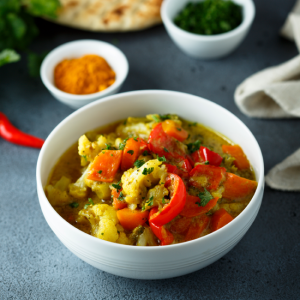
Thai Vegetable Curry: Step-by-Step Recipe
Instructions
Sautéing Curry Paste
- Firstly, put 2 tablespoons of oil in a pan. Maintain a low flame. Mix all the paste of Thai red curry.
- After that, cook it for a minute while stirring. It will have a lovely fragrance.
Add Vegetables
- Add 2 cups of chopped veggies and white button mushrooms. Combine together ½ cup of carrots chopped, ⅓ cup of baby corn chopped, 1 cup of button mushrooms chopped, ¼ or ⅓ cup chopped capsicum (or other coloured bell pepper), ¼ cup French beans and 1 cup chopped cauliflower (turkey berry).
Stir everything together
- After that, mix ½ cup thick coconut milk.
- Now add 1.5 cups of water and mix well. You may not need to add any additional salt because the Thai red curry paste already contains salt. After cooking, try it to see how it tastes. Reduce the amount of water if you prefer a thicker curry.
- After that, reduce the heat to medium-low and cover the pan with its lid. Cook the curry until the vegetables are soft.
- Reduce the heat to low and add 12 cups of thick coconut milk. You can leave the vegetables a little undercooked if you like.
- At last, combine it well and bring the entire curry to a low boil. Finally, stir in 1 tablespoon of chopped Thai basil leaves.
Making Thai Red Curry Paste
- First, set aside the spices. For instance, dried red chillies, bird's eye chillies, cumin seeds, black peppercorns and coriander seeds.
- Next, rinse, peel, and roughly chop garlic, galangal, kaffir and shallots. Do the same with lime leaves, and lemon grass stalks.
- Put the spices, shallots, and herbs in a jar grinder. Add 2 tablespoons of water, the soy sauce and (optional) lemon zest. Add salt as well.
Cook Veggies
- Furthermore, heat the coconut oil in a pan. Add the Thai red curry paste. Add the chopped vegetables, for instance, white button mushrooms. You can include whatever vegetables you choose. Combine everything.
- Add ½ cup of thick coconut milk now. Mix once more.
- After that, add water. Salt is not necessary because it was already included in the Thai curry paste. But, taste the curry later, and if you need more salt, then add it.
- At last, increase the heat to medium-low and cover the pan with its lid. Simmer the curry until the vegetables are tender and cooked through.
Making Thai Red Curry
- When the vegetables are tender, reduce the heat to low and add ½ cup thick coconut milk. If you prefer, you can leave the vegetables mild and undercooked.
- You can also add ¼ teaspoon palm sugar or unrefined cane sugar at this point. Sugar is optional and you can leave it out. Increase the amount of sugar for a mild sweeter taste. Mix well and bring the entire curry to a low or medium-low boil. Finally, stir in 1 tablespoon of chopped or ripped Thai basil leaves.
Notes
- Rich Creamy Curry: Full-fat coconut milk is the best option for a creamy and rich curry.
- Fast-cooking vegetables: Along with creaminess, It is important to add the fast-cooking vegetables at the end. Then simmer for a short while to maintain their crispness and tenderness.
- Control the heat: Some store-bought curry pastes can be rather hot, so start with a tablespoon and add more as necessary.
- Tofu: You can also add Pan-fried or air-fried tofu to the Thai red curry to give it a restaurant-style flavour.
- Use fresh herbs: For the finest taste in the curry, use fresh basil, cilantro, and kaffir lime leaves.
- Steam the veggies: if your curry sauce is too thick, add some broth for more flavour. You need to steam the vegetables in water if they aren't fully cooked.
- Use of coconut milk: Avoid coconut milk with the label “lite” or “low fat”.
- Use of Chicken: If you want to add chicken then, Cut 1-inch chunks of chicken breast or thighs. Season with salt and pepper to taste. Before precooking the vegetables, cook chicken in oil for 10-12 minutes till the pink goes. Set aside and return the cooked chicken to the pot at the end. Allow the chicken and vegetables to soak up the curry for 5 minutes.

